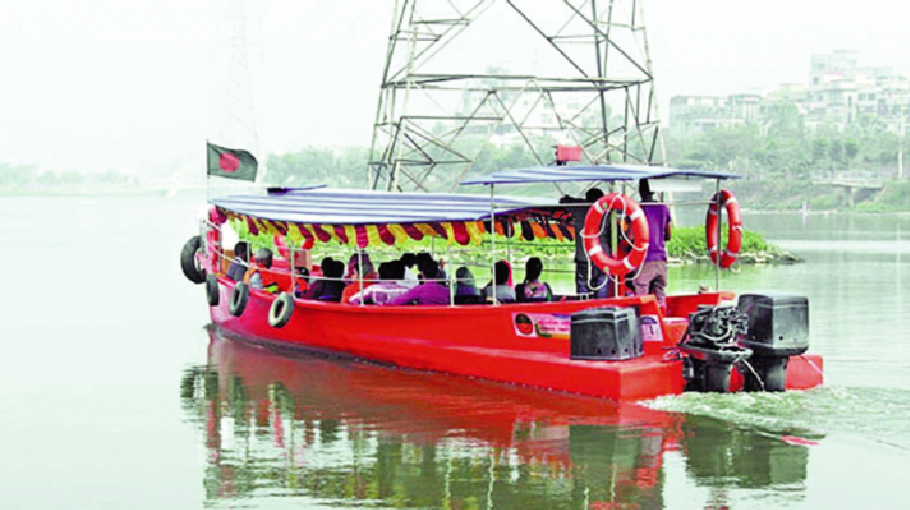Dhaka to come under Blue Network

The government is going ahead with its plan to create ‘Blue Network’ for the capital city of Dhaka with a view to ensuring improved transportation in the mega city.
The ‘Blue Network’ also aims to make Dhaka as a water sensitive city by protecting and restoring the canals and other waterbodies in and around the capital.
The Ministry of Water Resources and the Ministry of Environment, Forest and Climate Change are now seriously considering the development of the ‘Blue Network’ encompassing all the canals. The two ministries are actively working on an action plan to implement this vision.
The authorities concerned will have to recover the canals and waterbodies in the city, while they will also excavate the canals, plant trees, construct walkways and bicycle lanes on the banks of the canals and waterbodies as part of the ‘Blue Network’.
A project will be taken to implement the plan. “The initial plan is expected to be ready within the next month,” Syeda Rizwana Hasan, adviser to the Ministry of Environment, Forest and Climate Change; told the Bangladesh Post on Saturday.
It is learnt from sources that the project for ‘Blue Network’ will be undertaken in coordination with the Rajdhani Unnayan Kartripakkha (RAJUK), the Detailed Area Plan (DAP) and the city corporations of Dhaka.
Syeda Rizwana Hasan said, “We are planning to create the ‘Blue Network’ by restoring the canals of Dhaka city. A special plan for the capital’s wetlands is being taken. Various organisations need to take action in this regard, as all the canals are not under the control of any single entity. We will collaborate with the organisations managing the canals to proceed with efforts to eliminate encroachments and decontaminate them.”
She also said that the Blue Network will be established through the canals that can still be recovered. “We didn’t have the opportunity to create comprehensive plans for the canals. Recent floods and other national issues diverted our focus from this matter,” she said.
Syeda Rizwana Hasan made such comments also in an event at the auditorium of the Forest Department in the capital on Saturday. She was speaking as the chief guest at the event titled ‘Spatial and Temporal Changes in Dhaka City’s Urban Ecosystem, Landscape and Biodiversity over the Past 100 Years and Formulation of Strategic Action Plan’ organised by CEGIS.
Rizwana said she has long advocated for the restoration of canals of Dhaka city and is now actively considering the plan to create ‘Blue Network’. A project will require coordination and substantial financial investment, she added.
She stressed that RAJUK should conduct weekly operations to reclaim illegally occupied canals. She also mentioned that no wrongdoing should be legalised, and operations should be intensified if necessary.
The Environment Adviser highlighted the need to plant grass in open spaces of Dhaka city and involve the community in this effort. She further emphasised that urban planning for the capital city must prioritise greening, biodiversity conservation and wetland preservation.
She called for environmentally compatible urban development plans and stressed the need for coordinated efforts among all departments to protect and expand green and wetland areas.
Urban planners, environmentalists and right activists welcomed the government’s move for introducing ‘Blue Network’. “Waterbodies in and around Dhaka city are facing destruction as these are being filled up to construct multi-storied buildings. Against this backdrop, it is high time that proper steps must be taken to revitalize the waterbodies to create a blue network within the city,” said Mohammad Azaz, chairman of River and Delta Research Centre (RDRC).
Talking to the Daily Bangladesh Post on Saturday, Mohammad Azaz said that in the past, the transportation in Dhaka city was dependent on its waterways. Once waterways are re-established and rivers and canals are reconnected through introducing a blue network in and around Dhaka city connecting the major roads, the transport system will improve significantly, he added.
Connecting the whole Dhaka city through water the network will bring positive results for the people, said Advocate Syed Mahbubul Alam Tahin, a rights activist.
Dhaka was crisscrossed with numerous canals and low-lying areas. As the rapid urbanisation progressed, the wetlands of the city started to decrease rapidly.
According to a study, 84 percent of wetlands and waterbodies in and around Dhaka city have disappeared since 1947. There are 43 canals flowing through Dhaka city. However, 17 of these exist only in the map. Five of the remaining 26 canals have been filled up by dumping waste and encroached by illegal settlers. Most of the surviving 21 canals have been reduced to shallow streams.
There is a total 1,327km waterway in and around Dhaka city. According to an earlier plan taken by RUJUK, some 574km of waterway will be divided into three parts so that pressure on the road reduces.
Existing bridges on the circular waterway will be renovated and rebuilt so that 25-foot high water vessels can move beneath them. Besides, extensive dredging and digging will be needed to increase the navigability of major rivers and canals.
Alongside the RAJUK, the Dhaka North City Corporation (DNCC) had also taken an initiative to create an integrated ‘blue network’ at DNCC area to resolve the waterlogging. A project to build the network was sent to ECNEC approval and a study was also carried out in this regard. The study identified 48 existing canals in the 18 wards of DNCC.
Under the initiative, the DNCC wanted to develop the Naria-Beraid canal. Its length is 9.5km, while the width ranges from 12.53m to 115m, which is very unsuitable for natural water flow. The canal originates from the Balu river and then runs through Aftabnagar, Badda, Shahjadpur, Sutibhola, Satarkul, Kathaldia and Beraid areas.
According to the study, Satarkul canal in Badda is another waterbody which was significantly choked at different points because of grabbing. The Sutibhola part of the canal was filled up and lost its link with other parts.




